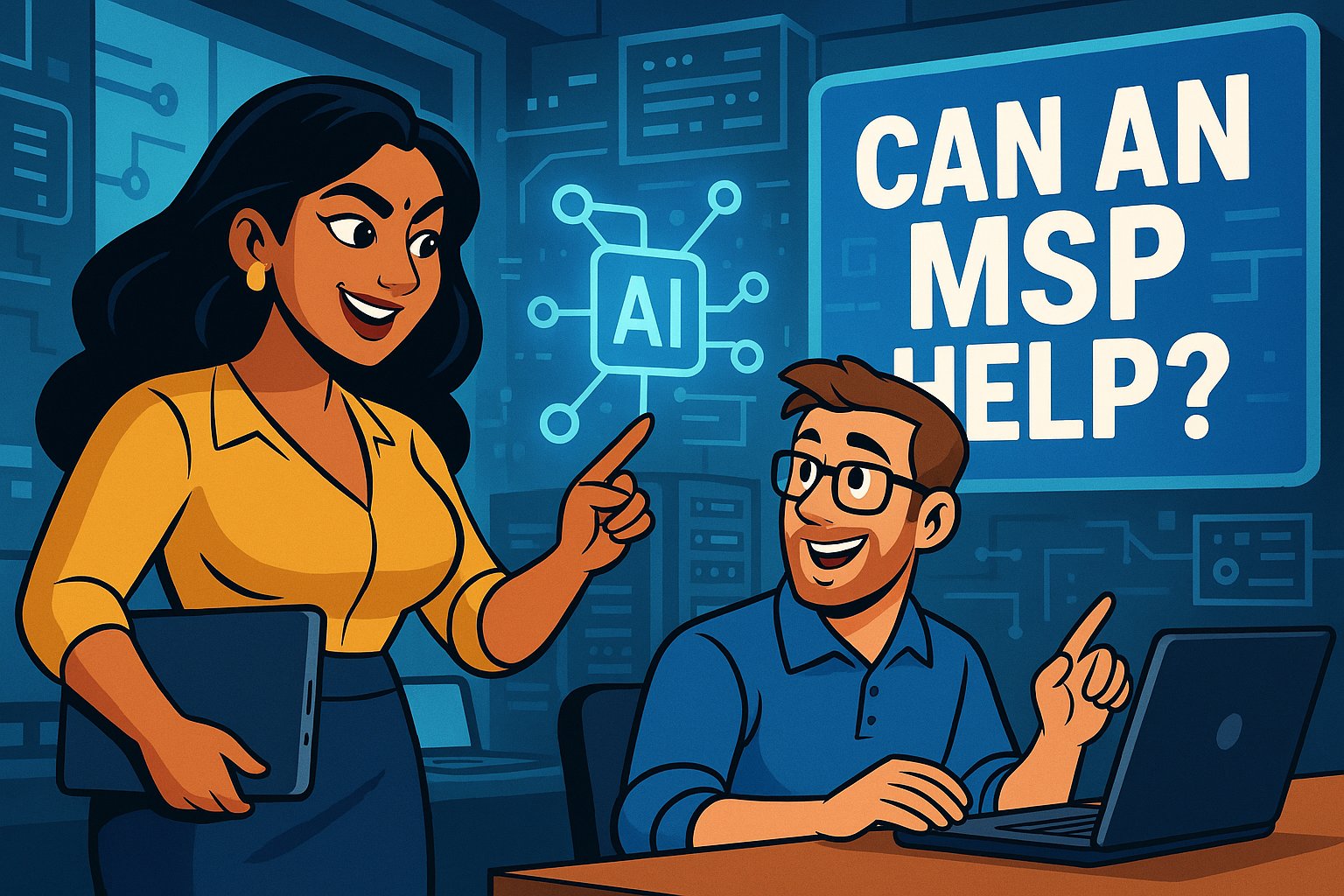How Can Your Outsourced IT Company Assist With Your AI Integrations: A Complete Guide
Outsourcing your IT services can be pivotal in making AI integration smoother, faster, and more cost-effective. Your outsourced IT company can bridge the gap between your existing systems and AI solutions by providing the technical expertise, infrastructure, and ongoing support needed for a seamless rollout. This means you can focus on business goals while they handle the complex implementation details.
With the right partner, you gain access to specialists who understand how to align AI tools with your operational needs. From automating repetitive processes to enhancing data analysis, an experienced outsourcing team can help you unlock AI’s practical benefits while ensuring security and compliance remain intact.
You can implement AI without overextending internal resources by leveraging its scalability and industry knowledge. This approach allows you to adapt quickly to new demands, optimize workflows, and improve customer experiences—all while controlling costs.
Key Takeaways
- Outsourced IT teams can manage AI integration from planning to execution
- Expert support ensures secure, compliant, and efficient implementation
- Scalable solutions help optimize operations and reduce overall costs
Understanding AI Integration with Outsourced IT Companies
When you work with an outsourced IT company on AI adoption, you gain access to technical expertise, implementation resources, and scalable infrastructure. This collaboration can help you deploy artificial intelligence in ways that align with your operational goals and existing systems.
What Is AI Integration?
AI integration embeds artificial intelligence tools and capabilities into your existing systems, workflows, and data infrastructure. It involves connecting AI models with your operational software to process information, make decisions, or automate tasks.
You may integrate AI for predictive analytics, process automation, or natural language processing. Each use case requires careful planning to ensure compatibility with your technology stack.
Integration often includes:
- Data preparation for AI model training
- API connections between AI services and applications
- Workflow adjustments to incorporate AI-driven outputs
A well-structured integration ensures your AI solutions operate within your business environment without disrupting core processes.
The Role of Outsourced IT in AI Projects
An outsourced IT company can act as your AI outsourcing partner by providing the technical skills and resources you may not have in-house. They can handle the end-to-end process, from selecting the right AI solutions to integrating them into your infrastructure.
They may also manage vendor relationships with AI platform providers, addressing licensing, compliance, and scalability. This is especially valuable if you lack internal AI expertise.
Outsourced teams often offer:
- Specialized AI engineering skills
- Project management for AI deployments
- Ongoing monitoring and optimization
By leveraging their experience, you can reduce integration risks and accelerate deployment timelines.
Types of AI Solutions Available
AI solutions vary widely in function and complexity. Common categories include:
| AI Solution Type | Example Use Cases | Typical Integration Method |
|---|---|---|
| Machine Learning Models | Demand forecasting, fraud detection | API or embedded model |
| Natural Language Processing (NLP) | Chatbots, sentiment analysis | Cloud AI services |
| Computer Vision | Quality inspection, facial recognition | Edge devices or cloud |
| Robotic Process Automation (RPA) | Data entry, report generation | Workflow automation tools |
You can select from off-the-shelf AI services or custom-built models when working with an outsourced IT provider. The choice depends on your data needs, budget, and desired control over the solution.
Benefits of AI Outsourcing
Partnering with an AI outsourcing provider can lower the cost and complexity of AI integration. You avoid the expense of recruiting and training in-house AI specialists while gaining immediate access to skilled professionals.
You also benefit from their experience across multiple industries, which can help you identify proven AI strategies. Many providers offer flexible service models, allowing you to scale AI capabilities up or down as needed.
Working with an experienced partner can also improve compliance and security. For example, some outsourced IT companies specializing in AI ensure that data handling meets regulatory standards while maintaining system performance.

AI Integration Services Offered by Outsourced IT Companies
When you work with an outsourced IT partner, you gain access to specialized teams that can design, build, and integrate AI systems into your existing infrastructure. These services often include end-to-end development, model training, and deployment strategies that align with your operational goals and compliance requirements.
Custom AI Development and Deployment
Your outsourced IT company can create custom AI solutions tailored to your workflows, data sources, and business objectives. This involves requirements analysis, architecture design, and integration planning to ensure compatibility with your current systems.
Development may include generative AI models, predictive analytics, or automation tools that address specific challenges. Depending on your security and scalability needs, the team can also handle cloud-based or on-premise deployments.
A structured deployment process often includes:
- Prototype creation for early validation.
- Pilot testing in controlled environments.
- Full-scale rollout with monitoring and optimization.
By outsourcing, you reduce the need for in-house AI engineering while gaining access to a broader technology stack and experienced developers.
Machine Learning Model Implementation
Your IT outsourcing partner can help you implement machine learning models that process large datasets, identify patterns, and produce actionable insights. This can include supervised, unsupervised, or reinforcement learning models.
They will manage data preprocessing, feature engineering, and model selection to ensure accuracy and efficiency. Many companies also provide model retraining schedules so your AI remains effective as new data emerges.
For example, an outsourced team could integrate a predictive maintenance model into your ERP system, reducing downtime and repair costs. They can also deploy models to cloud environments for scalable compute resources, avoiding the expense of on-premise hardware.
Natural Language Processing and NLP Solutions
Your outsourced IT provider can deliver natural language processing (NLP) solutions if you handle large volumes of text or speech data. These can include AI chatbots, sentiment analysis tools, automated document classification, and multilingual customer support systems.
By integrating NLP into your CRM or helpdesk software, you can automate routine communication and improve response accuracy. Many providers, such as those offering AI integration services, ensure compatibility with your existing platforms while maintaining data security standards.
Advanced NLP models can also be fine-tuned for industry-specific terminology, ensuring the AI understands and responds appropriately to specialized language. This is especially valuable for legal, medical, or technical sectors.
Computer Vision and Facial Recognition
Your outsourced IT company can integrate computer vision systems that process images and videos for quality inspection, object detection, or security monitoring.
Facial recognition solutions can be deployed for secure access control, attendance tracking, or customer identification in retail environments. These systems often use deep learning models trained on large datasets to achieve reliable accuracy.
Integration may involve connecting vision systems to existing surveillance infrastructure or embedding them into mobile and web applications. Outsourced teams can also optimize these models for real-time processing to support instant decision-making in high-traffic environments.
Computer vision can provide measurable insights into operational performance, compliance, and safety when combined with analytics dashboards.
Optimizing Business Workflows and Customer Experiences
You can use AI tools within your outsourced IT services to streamline repetitive tasks, anticipate operational needs, and deliver more personalized customer interactions. These capabilities help you reduce delays, improve accuracy, and strengthen the quality of every customer touchpoint.
Workflow Automation and Operational Efficiency
AI-driven workflow automation can handle routine processes such as data entry, ticket routing, and system monitoring without requiring manual intervention. This reduces the likelihood of human error and frees your in-house team for higher-value work.
Your outsourced IT company can integrate automation platforms with your existing systems to ensure smooth data flow between departments. For example, linking CRM software with AI tools can automatically update customer records after every interaction.
Key benefits include:
- Faster task completion
- Reduced operational costs
- Consistent process execution
Combining automation with real-time monitoring lets you detect inefficiencies early and adjust workflows to maintain peak operational efficiency.
Predictive Analytics and Actionable Insights
With AI-powered predictive analytics, you can identify patterns in large datasets and forecast future outcomes. This lets you plan resources, manage inventory, and accurately anticipate customer demand.
Your outsourced IT partner can configure analytics tools to pull data from multiple sources, such as sales records, website behavior, and support logs. By doing so, you gain actionable insights that guide decision-making.
For example, predictive models can highlight which products will likely increase demand next quarter, enabling you to adjust procurement strategies in advance. This reduces waste and improves profitability.
Enhancing Customer Service with AI-Powered Chatbots
AI-powered chatbots can respond to common customer queries instantly, 24/7. This ensures faster resolution times and reduces the workload on your human support agents.
Your outsourced IT company can integrate these chatbots with your helpdesk and CRM systems so that they not only answer questions but also log interactions for future reference.
Standard chatbot functions include:
- Providing order status updates
- Answering product FAQs
- Directing customers to relevant resources
By maintaining consistent and accurate responses, chatbots help improve customer satisfaction while keeping service costs manageable.
Personalizing Customer Experience with Virtual Assistants
Virtual assistants use AI to tailor recommendations, reminders, and offers to each customer’s preferences and behavior. This level of personalization can increase engagement and loyalty.
Your outsourced IT provider can deploy virtual assistants across multiple channels, including websites, mobile apps, and voice platforms. These assistants can access customer history to suggest relevant products or services in real time.
For example, a virtual assistant could remind customers when to reorder a subscription product or suggest complementary items based on past purchases. This creates a smoother and more relevant customer experience.
Ensuring Data Security, Privacy, and Compliance
When integrating AI through an outsourced IT partner, you must safeguard sensitive information, meet regulatory obligations, and control who can access critical systems. Strong encryption, privacy-focused processes, and well-defined access policies are essential to protect your business from breaches and legal risks.
Data Security and Encryption Best Practices
Your outsourced IT company should implement end-to-end encryption for data both in transit and at rest. This prevents unauthorized interception or tampering during transfer between systems.
They can configure TLS/SSL protocols, encrypted VPN tunnels, and disk-level encryption for servers and devices. Where applicable, use AES-256 or equivalent encryption standards for maximum protection.
Regular security audits help verify that encryption keys are rotated, stored securely, and managed according to industry standards. Key management should follow least privilege principles, ensuring only authorized personnel can access encryption credentials.
You can also request that your provider adopt multi-factor authentication for all administrative access. This adds an extra layer of security to encrypted systems and reduces the risk of compromised credentials.
If your AI integration involves cloud storage or processing, confirm that the provider’s environment meets recognized frameworks like ISO 27001 or PCI DSS for data handling. This ensures encryption is part of a broader, certified security program.
Data Privacy and Regulatory Compliance
Your outsourced IT partner should help you comply with privacy regulations such as GDPR in the EU and CCPA in California. This means ensuring personal data is collected, stored, and processed only for legitimate purposes.
They can configure AI systems to anonymize or pseudonymize personal information where possible. This reduces the risk of identifying individuals if data is exposed.
Clear data retention policies are essential. You should define how long AI-related datasets are stored and ensure timely deletion when no longer needed.
Ask your provider to document data flows so you understand where information resides and which systems process it. This documentation supports compliance audits and regulatory inquiries.
If your AI processes sensitive categories of data, such as healthcare or financial records, your IT partner should implement privacy impact assessments before deployment. This helps identify and address potential compliance gaps early.
Risk Mitigation and Access Controls
Strong access controls limit exposure of sensitive AI datasets and system configurations. Your outsourced IT company can implement role-based access control (RBAC) so users only see the data necessary for their tasks.
They should enforce multi-factor authentication and monitor all administrative sessions. Real-time alerts for unusual activity help detect potential breaches quickly.
Physical security measures, such as secure server rooms and restricted entry points, add another layer of protection for on-premise infrastructure.
Your provider should also create incident response plans that outline steps to contain and remediate security events. Regular testing of these plans ensures readiness.
For high-risk AI workloads, consider network segmentation to isolate sensitive processing environments from general business systems. This reduces the chance of lateral movement in case of a breach.
Ongoing user training on secure data handling is equally important. Even with strong technical measures, human error remains a leading cause of security incidents.
Achieving Scalability and Cost Efficiency Through Outsourcing
Outsourcing your IT operations can give you access to specialized talent, advanced tools, and flexible service models that support sustainable growth. By leveraging external expertise, you can align technology investments with business goals while controlling operational costs.
Scaling AI Solutions for Business Growth
When you outsource IT, you can scale AI solutions without overextending internal resources. Providers can quickly add computing power, storage, and development capacity as your AI workloads increase.
This rapid scaling helps you handle spikes in data processing or user demand without investing in expensive infrastructure. For example, IT outsourcing for scalability enables you to adopt new AI models or expand existing ones without long procurement cycles.
Outsourced teams often have experience with multiple AI frameworks, making integration into your existing systems faster and more reliable. Depending on your operational needs, you can also benefit from their ability to deploy solutions across cloud, hybrid, or on-premise environments.
Cost Efficiency Strategies with Outsourced IT
Outsourcing allows you to convert fixed costs into variable costs. You only pay for the services and resources you use, which reduces waste and improves budget predictability.
Many providers achieve economies of scale, delivering services at a lower cost than building and maintaining the same capabilities in-house. This can include access to AI-ready infrastructure, licensed software, and pre-trained models at reduced rates.
Some companies also use cost-efficient outsourcing models that combine offshore and onshore teams. This approach balances lower labor costs with the need for local expertise, ensuring both savings and quality.
Flexible Resource Allocation and Project Management
With outsourced IT, you can scale project teams up or down as AI development phases change. This flexibility is especially valuable for projects that require rapid prototyping followed by smaller maintenance teams.
Providers can assign specialists for short-term needs, such as AI model training or data labelling, without long-term hiring commitments. This reduces downtime and keeps your workforce aligned with current project priorities.
Strong project management practices, such as agile methods and regular performance reviews, help maintain alignment with your business goals. Using tools for real-time collaboration ensures clear communication between your internal team and the outsourcing partner, improving delivery timelines and reducing project risks.
Addressing Challenges and Best Practices in AI Outsourcing
When you outsource AI-related work, you face both technical and operational challenges. Clear integration processes, structured communication, and responsible use of AI tools are essential to ensure consistent results and regulatory compliance.
Overcoming Integration Challenges
Integrating outsourced AI tools with your existing systems requires careful planning. You must confirm that the provider’s technology stack is compatible with your infrastructure. Mismatched systems can cause delays, data inconsistencies, or reduced functionality.
Create a technical integration checklist that covers:
- Data format and API compatibility
- Security protocols and encryption standards
- Testing procedures before deployment
You should also schedule joint technical workshops with your outsourcing partner. These sessions help align workflows, clarify dependencies, and prevent misinterpretations.
If your outsourced IT company has experience in AI integration best practices, they can proactively identify potential bottlenecks and suggest workarounds. This reduces downtime and ensures your AI systems operate as intended after deployment.
Establishing Effective Feedback Loops
Strong feedback loops ensure that outsourced AI services remain aligned with your objectives. Before the project begins, you should define measurable performance indicators, such as accuracy rates, processing times, or customer satisfaction scores.
Use regular review cycles to evaluate results:
- Weekly or bi-weekly status meetings
- Performance reports with clear metrics
- Action plans for adjustments
Shared dashboards and collaborative project management tools can make the process transparent. This allows you and your provider to track real-time progress and make timely corrections.
Your outsourced IT partner can also implement automated monitoring systems that flag anomalies in AI outputs. By acting on these alerts promptly, you can maintain quality and avoid costly rework.
Ethical AI Implementation
Ethical AI practices protect your business from legal and reputational risks. You should verify that your outsourcing partner follows established fairness, transparency, and data privacy guidelines.
Key areas to review include:
- Bias detection in AI models
- Data governance policies for handling sensitive information
- Explainability of AI decisions to stakeholders
If your partner offers ethical AI deployment expertise, they can help you meet compliance requirements in multiple jurisdictions.
You should also request documentation of how AI models are trained, tested, and updated. This ensures you can audit the process and confirm it aligns with your company’s values and regulatory obligations.


